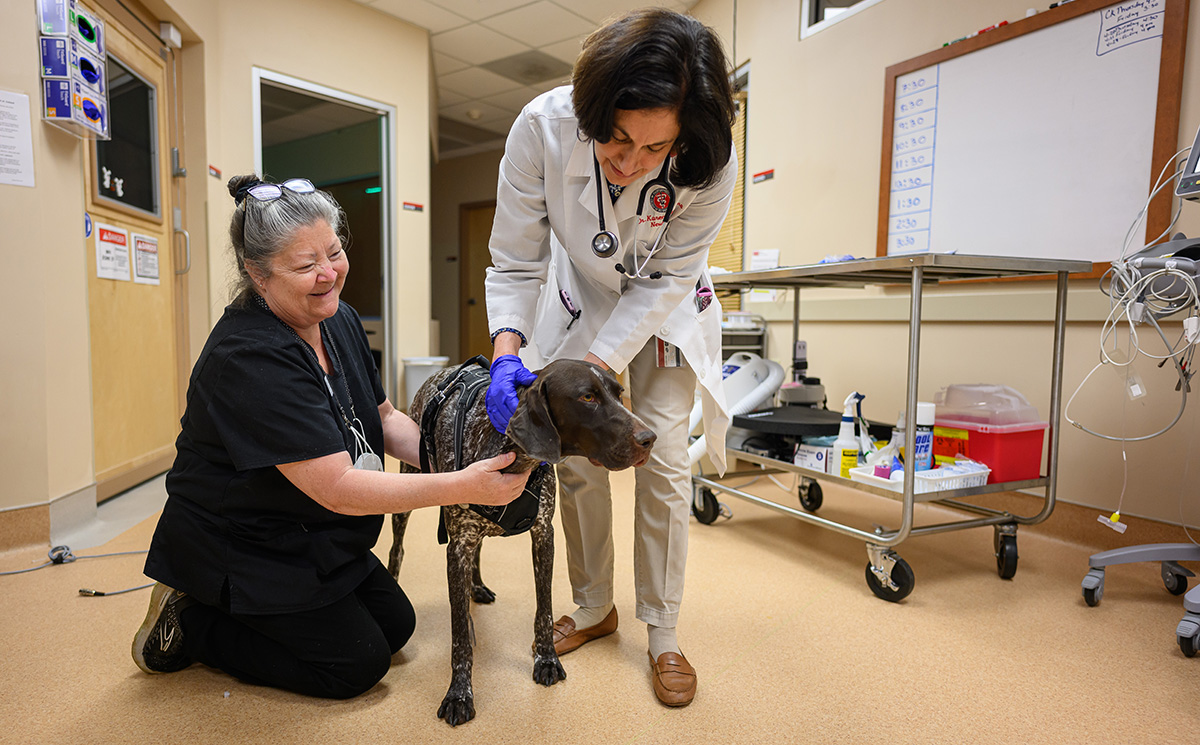How Our Researchers Are Leading the Way in Canine Epilepsy Research

Though we typically think of epilepsy as a human disorder, one out of every 100 dogs has been diagnosed with it. That’s about 500,000 dogs with the neurological disease that causes seizures, which can be life-changing for both the dog and its owner.
Led by Professor of Neurology Dr. Karen Muñana and Research Specialist and Registered Veterinary Technician Julie Nettifee, researchers at the NC State College of Veterinary Medicine’s Companion Animal Epilepsy Research Laboratory are working to better understand the disorder’s origins, find better treatment options and improve the quality of life for both animals and owners.
The research group has spent decades making strides in all three of those areas thanks to its holistic approach and to the support off a network of organizations focused on animal research and devoted pet owners who have experienced the challenges of a dog with epilepsy firsthand.
Muñana and Nettifee shared insights from their years of work and discussed how their approach to studying dogs with epilepsy and their owners is improving the lives of thousands.
What is epilepsy, and how does it impact dogs?
Muñana: Epilepsy is a disorder of the brain that causes recurrent seizures. It’s not due to what we call “provoked seizures.” In other words, it’s not due to a problem with an intoxication, like the animal getting into something outside or a problem with one of the organs in the body. So, an animal that has seizures because its blood glucose is low does not have epilepsy. Epilepsy is a recurrence of seizures due to an abnormality in the brain itself.
Epilepsy is a general term, so anything that causes an abnormality in certain areas of the brain can cause epilepsy. If a dog has a brain tumor, it can develop epilepsy. But specifically, what we tend to see most commonly in dogs is a disease called “idiopathic epilepsy,” and that is where the brain appears structurally normal — from what we can tell with testing such as MRI — but at a microscopic level or cellular level, there are some abnormalities. Idiopathic epilepsy can occur in any breed, but we see it more in certain breeds where it has been shown to be inherited. There are about 25 of those breeds and include golden retrievers, Labrador retrievers, collies, shelties, beagles, Australian shepherds, border collies and German shepherds.
In general, idiopathic epilepsy usually does not affect the lifespan of affected dogs. But for dogs that have severe epilepsy, it can actually impact their lifestyle. What happens, unfortunately, in many cases is because of the severity of the seizures and the impact on the dog and its caregiver, the dog is euthanized. So, some dogs can die from the seizures, but euthanasia is more common. In general, dogs with epilepsy can live a pretty normal life, albeit with seizures.
What exactly is a seizure? What’s happening inside the brain and what do we see as bystanders?
Muñana: Essentially, a seizure is abnormal, hypersynchronous, hyperexcitable activity in the brain. So, the normal electricity in the brain, which causes us to do things, becomes overexcited, and cells become synchronized. There’s essentially this storm in the brain, and it manifests in a lot of different ways. The type of seizure we think of most commonly is what we call a “generalized seizure.” We used to call these “grand mal seizures.” A generalized seizure causes repetitive, involuntary movement of pretty much the whole body. Animals typically lose consciousness. They’ll fall on their side. They’ll paddle. They’ll jaw chomp. They also can salivate. They can lose control of their bladder and bowels.
How do veterinarians treat epilepsy?
Muñana: Lifelong medication. Usually, it’s a pill. Depending on how severe their seizures are, several pills are given anywhere from once to three times a day for the rest of their life. That’s the big impact. Obviously, we’re very concerned about the animals and how they’re doing and their quality of life, but a huge impact is placed on the caregivers in terms of the financial outlay and the commitment to giving their animal medications for the rest of its life. What a lot of caregivers find really difficult is the uncertainty because seizures are unpredictable. We never know when they’re going to happen. Some dogs will have a seizure cycle where they’ll have a seizure every month, but a lot of times, it is unpredictable. So, caregivers are left to wonder when the next seizure is going to happen. Am I going to be there? Am I not going to be there? Is my dog going to be OK? This can really take a toll.
All we have available at the current time are ways to manage the disease. I think that’s really what we focus on mostly: How can we more effectively manage the disease? How can we more effectively support people who are managing these dogs and try to maximize their quality of life?
What is the NC State College of Veterinary Medicine doing to better understand epilepsy and provide support for dogs and their owners?
Muñana: Our research has been focused on a few things. One is that we’ve looked at different sorts of treatments for epilepsy. When a drug comes on the market for humans, we’ll say, “OK. Is this something that we can use in animals?” We do trials just like a human clinical trial to evaluate a new drug. Is this drug superior to a placebo in controlling seizures? We’ve also looked at dietary modification and surgical implants for seizures. So, we’re looking at conventional treatments, meaning drugs, and then maybe some unconventional or alternative treatments as well. We have recently received funding to undertake a study looking at drugs to treat cluster seizures, or multiple seizures in a 24-hour, in the home setting to try to minimize the need for caregivers to seek emergency veterinary care for dogs that tend to have multiple seizures over a short time span.
In addition, we perform research to better understand the cause of epilepsy. We’ve looked at how certain breeds of dogs have a mutation that causes some drugs to get into their brain in higher concentrations, and if that could impact how dogs respond to medications. We recently completed a study where we looked at the gut microbiome and how dogs with epilepsy might have differences in that. We have an ongoing study looking at functional MRI — a specific type of imaging that doesn’t really look at the structure of the brain but at the connections within the brain.
Then the third arm of our research involves quality of life. This is the quality of life of the dogs, but also focuses on the caregiver part and what can we do to help improve caregivers’ quality of life. We did a study looking at activity trackers specifically made for dogs to say, “Can we predict seizures?” If caregivers can predict seizures, then that uncertainty goes away. The activity trackers weren’t able to predict seizures, but we were able to identify some other things that can potentially improve caregivers’ quality of life.
Nettifee: We look at quality of life in both dogs and their caregivers. We look at those global impacts, from the physicality of giving medications three times a day to the costs of nutrition to other factors, both how it affects the caregiver and their pet, and even looking at how that pet with epilepsy can impact perhaps other animals in the household. The influence is not just the dog with epilepsy and the seizure, though that’s a big influence, but every time it happens, there’s a caregiver, there may be another pet or two or four in the household, and so looking at that global picture of what this looks like. Where can we, as a profession, provide education? Caregivers often obtain information from their veterinarian, but unfortunately, many resort to internet resources. We have worked to develop online resources for pet owners that are accurate and informative.
My focus is always on, “Can we do more to help these clients?” We’ve helped them to build a village of support because, just like a child with a disability, building a framework is very important so that not one single person is carrying the entire load. We help them to have enough resources so that they don’t feel like they’re just all alone with this disorder. So we really help them create that network once their pet is diagnosed with epilepsy, and that network includes the veterinary professional they’re working with, as well as connections with outreach groups that are disease-focused.
In terms of scientific research, what advances have been made at the NC State CVM and in the field?
Muñana: Just the amount of research is one thing. If you look at graphs showing the amount of research done before 1980, it is really very little. We had two drugs that we used, and when dogs failed those two drugs, we didn’t have much to offer. Now we have a handful of drugs, including several new drugs, and it’s mirroring what’s being done in human medicine. The treatment of epilepsy has advanced, so the options that are available and information on those drugs have expanded. So, we know a lot more about the drugs and what we need to do.
One of the most impactful things that has come out of our research is that we were the first group to report on placebo-controlled studies in epilepsy. Why do you need a placebo-controlled study for dogs with epilepsy? We found, actually, that there’s about a 30% placebo effect in epilepsy. If you have a dog on a placebo, about 30% of them will experience improvement in their seizures. The reason, I think, is epilepsy is a waxing and waning disease. The seizures get bad, and then they get better and bad and better, and caregivers come and look for a new treatment when the seizures are bad. So, we put their pet on the new treatment, and the seizures get better, and we’re attributing it to the drug or other new treatment versus the natural course of the disease. And what we’ve realized since then is that you have to really follow dogs out over a long enough period of time that you’re getting those ebbs and flows. A lot of published studies, because they’re time-limited, only catch maybe one cycle.
We were also the first group to evaluate a surgical treatment for epilepsy called vagus nerve stimulation in dogs, which is a tried and true treatment in humans, and we showed that it could be effective in some dogs. The treatment involves surgical implantation of a pacemaker-like device under the skin, with electrodes wrapped around a specific nerve in the neck. Studies have shown that stimulating the specific nerve can help with seizures.
What’s next for your research?
Muñana: The ultimate goal is to cure epilepsy. If you talk to dog breed groups, their hope is that we can find the genetic cause for epilepsy in their breed and develop a screening test to identify and eliminate epilepsy. That would be ideal. But I don’t think that’s going to happen in my lifetime as a researcher, so my goal has been really to work to maximize the quality of life for the pet and the caregiver and see what we can do to better control seizures and give everyone a happier life.
Nettifee: We are also training up the next generation of epilepsy researchers. We frequently have students, interns and residents in our lab. The foundation has been built very strongly here, and there’s opportunity going forward. We’re building into that next generation of scientists, veterinarians, neurologists, to continue to make a difference in this area, such that a cure is hopefully made possible in the future, to benefit both human and animal health.


